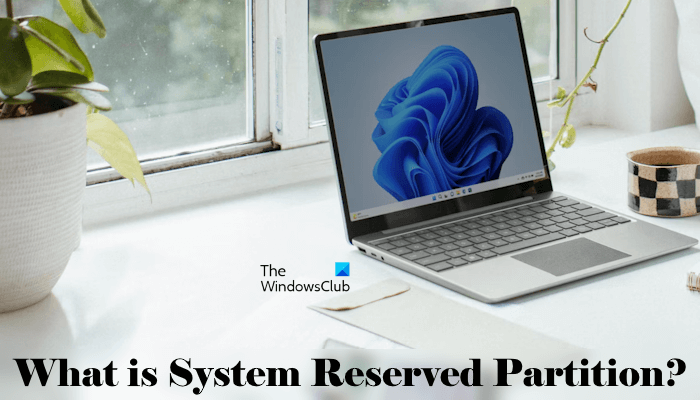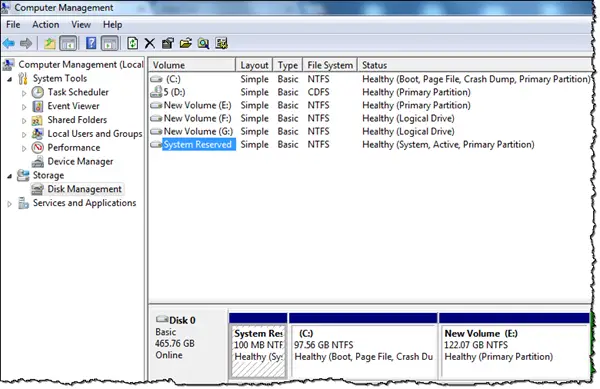When you install Windows 11/10 on a cleanly formatted disk, it first creates a partition on the disk at the beginning of the hard disk. This partition is called the System Reserved Partition. After that, it uses the remaining unallocated disk space to create your system drive and install the operating system. In this article, we will discuss what System Reserved Partition is.

When you open the Computer folder, you will not see the System Reserved Partition as it is not assigned a disk letter. You will only see the System Drive or the C Drive. To see the System Reserved Partition, you will have to open Disk Management.
In Windows 11/10, open the WinX Menu and click on Disk Management. Once the data is populated, you will be able to see the System Reserved Partition. You can also access it via Computer Management.
What is System Reserved Partition in Windows?
The System Reserved Partition holds the Boot Configuration Database, and Boot Manager Code, and reserves space for the startup files that may be required by BitLocker, in case you use the BitLocker Drive Encryption feature.

It is created during a clean, fresh installation of Windows 11/10 and Windows Server.
If you wish to view the contents of this partition, you will have to first give this partition a Drive Letter, using Disk Management. Next, open Folder Options and enable the hidden files, folders, and drive options, as well as protected operating system files. Once you have done this, open your File Explorer to view the partition and the files it contains. You may see files like bootmgr, BOOTNXT, BOOTSECT.bak and folders like Boot, Recovery, System Volume Information, $RECYCLE BIN, etc.
Read: What is the SYSTEM.SAV folder?
Can I delete the System Reserved Partition in Windows 11/10?
Do you need this space? I would recommend that you not delete this partition. Moreover, deleting this partition will not free up a huge space on your hard drive because its size is usually in Megabytes. You can instead prevent it from being created during Windows installation. If you are sure that you will not be using BitLocker, then you may go ahead.
To do this, TechNet recommends you use the Diskpart utility from the setup program.
At the beginning of the Windows setup, just before you select the location where you want to install Windows, press Shift+F10 to open a Command Prompt. Type diskpart to enter the Diskpart environment. Use select disk # and create partition primary to manually create a new partition. Replace # in the select disk command with the correct disk number. For example, if you have to select disk 0, type select disk 0. Continue with the Windows installation using this new partition as the setup location.
That’s it. I hope this helps.
Should I install Windows 11 on the System reserved partition?
You cannot install Windows on the System Reserved Partition. System Reserved Partition is small, usually having a size in Megabytes, whereas Windows installation is large, having a size in Gigabytes. Moreover, when you install Windows OS, a new system reserved partition is created automatically. Hence, installing Windows OS on the System reserved Partition is not possible.
In which partition should I install Windows 11?
If you are upgrading to Windows 11 from a lower version of Windows, say Windows 10, you need not format your hard drive partition. You can use the Media Creation Tool for this purpose. The installation of Windows 11 will proceed as expected. If you are performing a clean installation of Windows 11, you need to select the primary partition (C drive) of your hard disk to install Windows 11.
See these posts if:
- System Reserved Partition is missing in Windows
- You receive We couldn’t update the system reserved partition error.
I tried deleting the system reserved but the other drive got deleted, or might be hidden, as it is not showing in My Computer, Is there any solution for this?
Hi Anandk – bit confused over the naming of “System Reserved” and have a question for you. Hope you don’t mind.
I am recovering a Win 8.1 zero’d disk using testdisk and it identifies all the previous GPT partitions except for a 128Mb “Reserved” partition (no volume attached to this).
It has found a “System” Partition (300Mb) or to give it its vol label “ESP” and the Primary and others (Recovery etc).
The testdisk software can write that partition table back to the disk. What I’m not sure about is should I manually add that 128Mb partition back to the partition list before writing it to the drive, or should I ignore it as windows intends it to be hidden and will deal with it anyhow.
Any ideas? thanks
Hi according to Microsoft in W7 this boot partition should have a size of 100MB and in W8 it is a bit larger, they write between 350 MB and 500 MB. Sometime it is called system_reserved, sometimes SYSTEM. Anyhow it is the boot partition. There is no drive letter asigned to and it is hidden. If U messed up with the partition either tri to save ur key out of registry and/or BIOS. nirsoft has nice tools for that. Make a new setup of ur HDD. Suggest 400MB for the system (1st) partion, set it to active, primary. The 2nd partition make 400 GB for windows and the rest of HDD u define as data partition or whatever u want, Goog Luck!
diskmgmt.msc>Right click on missing drive>Change Drive letter and paths>Assign a letter to it
When I went to clean up and defrag my hard drive, I got a message saying that the system reserved was 100% fragmented, but it would not let me defrag it. Could this contribute to my system running slow?
W10 creates 3 additional junk partitions on my main drive. Can this be actually prevented ? W7 was fine without any additional spam partitions.
I don’t think Windows creates partitions on its own. Could it be the OEM?
No, any of them do that at installation. On 7, if your partition was already created, no additional slice was made. Not tested this with 10.
Win 7 setup by default selected separate drives for the system reserved partition and C: For fault tolerance, it makes sense.
so during windows cloning we have to clone the system partition too?